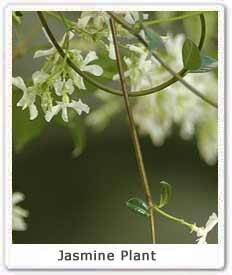| Kingdom : | Plantae |
| Division | Magnoliophyta |
| Class: | Magnoliopsida |
| Order : | Lamiales |
| Family : | Oleaceae |
| Genus : | Jasminum |
| Scientific Name : | Jasminum sambac (L.) Aiton |
| Found In : | Nagarhole National Park |
Other names : Moghra, Kundumalligai, Arabian Jasmine. Mallika are some of the other names used for the Jasmine. In India Jasmine is called the 'Moonshine in the garden'.
Description : Jasmine is a evergreen semi vining shrub. It grows to the height of 8- 10 feet. The flower is about one inch. It has oval green rich leaves, which have five to nine leaflets. Each leaflet is 2-3 inches long. Jasmine flowers are white in colour. Its stems are slender, trailing, green and glaborous.
Other Species : Jasminum amplexicule, Jasminum angulare, Jasminum angusgustifolium, Jasminum arborescens, Jasminum atttenuatum, Jasminum auriculatum, azoricum, Jasminum bessianum, Jasminum
 cinnamomifolium, Jasminum coffeinum, Jasminum crabibianum, Jasminum
cuspidatumkmkm are some of the related species of the Jasmine plant.
cinnamomifolium, Jasminum coffeinum, Jasminum crabibianum, Jasminum
cuspidatumkmkm are some of the related species of the Jasmine plant.Location : Jasmine plant is found in almost all the parts of India. They are widely grown in the Nagarhole National Park in India.
Cultivation methods : It is propagated through the softwood cuttings, semi hard wood cuttings and through simple layering. It needs water regularly. It is mostly propagated in the summer season. It is planted 6 inches deep inside the soil. It requires moist and well drained soil. Remove the weeds present inside the soil before planting the tree. The soil should consists of cow dung before planting the Jasmine plant. It requires frequent pruning for its fast growth. It needs warm temperature and proper watering from time to time. It grows in full Sun to partial shade. It should be fertilized in a month period. Jasmine Plant should be kept at least eight feet apart in order to save the later growth of the plant from jamming together. Tips of the plants should be pinched to stimulate lateral growth and frequent prunning. Younger plants should be tied with the stems to give a fairly heavy support.
Medicinal uses : The Jasmine flower is used for removing intestinal worms and is also used for jaundice and venereal diseases. The flower buds are useful in treating ulcers, vesicles, boils, skin diseases and eye disorders. The leaves extracts against breast tumours. Drinking Jasmine tea regularly helps in curing cancer. Its oil is very effective in calming and relaxing.
Other uses : Jasmine oil is used used for making perfumes and incense. Its flowers are used to flavour Jasmine tea and other herbal or black tea. Its oil is also used in creams, shampoos and soaps. In India Jasmine flowers are stringed together to make garlands. Women in India wear this flower in their hair. Some communities even use this flower to cover the face of the bridegroom.
Cultural Importance : In India the Jasmine plant is related to Lord Shiva and Lord Vishnu. Jasmine flowes are used in the religious offerings.






